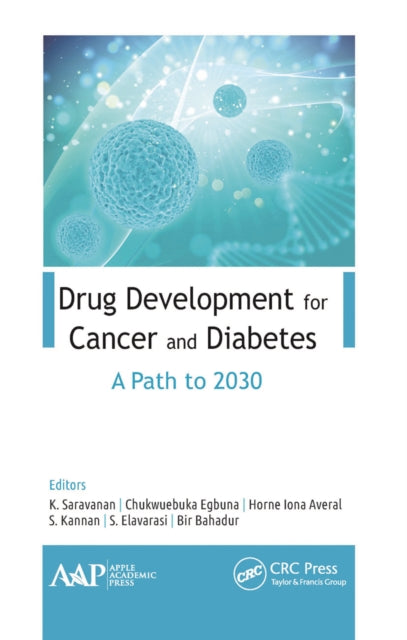Shulph Ink
Drug Development for Cancer and Diabetes: A Path to 2030
Drug Development for Cancer and Diabetes: A Path to 2030
YOU SAVE £3.99
- Condition: Brand new
- UK Delivery times: Usually arrives within 2 - 3 working days
- UK Shipping: Fee starts at £2.39. Subject to product weight & dimension
Bulk ordering. Want 15 or more copies? Get a personalised quote and bigger discounts. Learn more about bulk orders.
Couldn't load pickup availability
- More about Drug Development for Cancer and Diabetes: A Path to 2030
Plants play a crucial role in treating and managing cancer and diabetes through phytocompounds. Phytochemicals can act as ligands for cancer and diabetic targets, and plants have the potential to be used as antidiabetic and anticancer drugs. Green biosynthesis of nanoparticles is also an efficient treatment for cancer.
Format: Paperback / softback
Length: 362 pages
Publication date: 28 February 2022
Publisher: Apple Academic Press Inc.
Here is the rephrased text:
Plants have been used for centuries to treat and manage various diseases, including cancer and diabetes. Phytocompounds, which are natural compounds found in plants, have been shown to have potential therapeutic benefits for these conditions. In this article, we will explore the role of plants in the treatment and management of cancer and diabetes, as well as the role of phytocompounds as ligands for cancer and diabetic targets.
Plants have been used for centuries to treat and manage various diseases, including cancer and diabetes. Phytocompounds, which are natural compounds found in plants, have been shown to have potential therapeutic benefits for these conditions. In this article, we will explore the role of plants in the treatment and management of cancer and diabetes, as well as the role of phytocompounds as ligands for cancer and diabetic targets.
Studies have shown that certain plants contain compounds that can inhibit the growth and spread of cancer cells. For example, turmeric, a spice commonly used in Indian cuisine, has been shown to have anti-cancer properties. Turmeric contains a compound called curcumin, which has been shown to inhibit the growth of various types of cancer cells, including breast, colon, and lung cancer.
Another plant that has been studied for its potential anti-cancer properties is garlic. Garlic contains compounds called allicin and selenium, which have been shown to have anti-cancer effects. Allicin is responsible for the garlic's pungent taste and smell, while selenium is believed to help protect cells from damage caused by free radicals.
In addition to their anti-cancer properties, plants have also been shown to have potential benefits for the treatment of diabetes. For example, bitter gourd, a vegetable commonly used in Indian cuisine, has been shown to improve insulin sensitivity and reduce blood sugar levels in people with diabetes. Bitter gourd contains a compound called charantin, which has been shown to stimulate the production of insulin in the pancreas and improve glucose metabolism.
Phytocompounds have also been shown to have potential as antidiabetic and anticancer drugs. For example, resveratrol, a compound found in red wine, has been shown to have anti-diabetic properties by improving insulin sensitivity and reducing blood sugar levels. Resveratrol has also been shown to have anti-cancer properties by inhibiting the growth and spread of cancer cells.
Green biosynthesis of nanoparticles has also been explored as a potential treatment for cancer and diabetes. Nanoparticles are tiny particles that have been engineered to have specific properties, such as size, shape, and surface chemistry. Green biosynthesis of nanoparticles involves the use of plants as a source of raw materials for the production of nanoparticles.
Studies have shown that green biosynthesis of nanoparticles can be more efficient than traditional methods of nanoparticle production, such as chemical synthesis. Green biosynthesis of nanoparticles also has the potential to reduce the environmental impact of nanoparticle production, as it does not involve the use of harmful chemicals.
In conclusion, plants have been used for centuries to treat and manage various diseases, including cancer and diabetes. Phytocompounds, which are natural compounds found in plants, have been shown to have potential therapeutic benefits for these conditions. In this article, we have explored the role of plants in the treatment and management of cancer and diabetes, as well as the role of phytocompounds as ligands for cancer and diabetic targets. We have also discussed the green biosynthesis of nanoparticles and their potential as a treatment for cancer and diabetes. Further research is needed to fully understand the potential benefits of plants and phytocompounds in the treatment of cancer and diabetes, and to develop effective treatments that can be used by people around the world.
Weight: 632g
Dimension: 156 x 233 x 24 (mm)
ISBN-13: 9781774634936
This item can be found in:
UK and International shipping information
UK and International shipping information
UK Delivery and returns information:
- Delivery within 2 - 3 days when ordering in the UK.
- Shipping fee for UK customers from £2.39. Fully tracked shipping service available.
- Returns policy: Return within 30 days of receipt for full refund.
International deliveries:
Shulph Ink now ships to Australia, Belgium, Canada, France, Germany, Ireland, Italy, India, Luxembourg Saudi Arabia, Singapore, Spain, Netherlands, New Zealand, United Arab Emirates, United States of America.
- Delivery times: within 5 - 10 days for international orders.
- Shipping fee: charges vary for overseas orders. Only tracked services are available for most international orders. Some countries have untracked shipping options.
- Customs charges: If ordering to addresses outside the United Kingdom, you may or may not incur additional customs and duties fees during local delivery.


